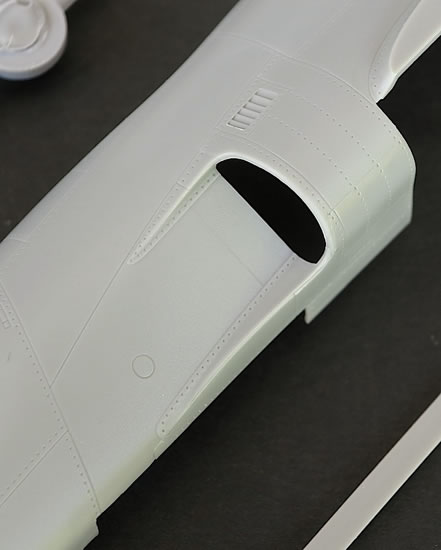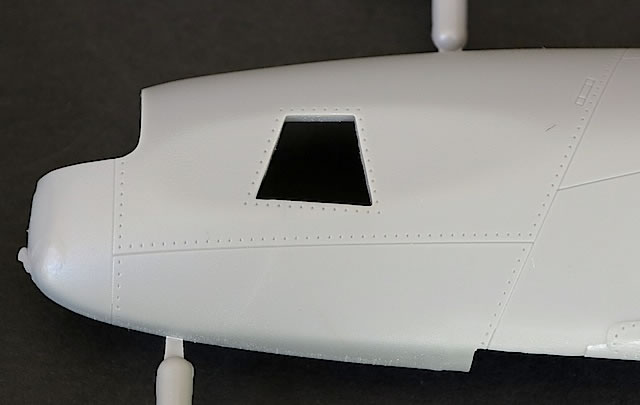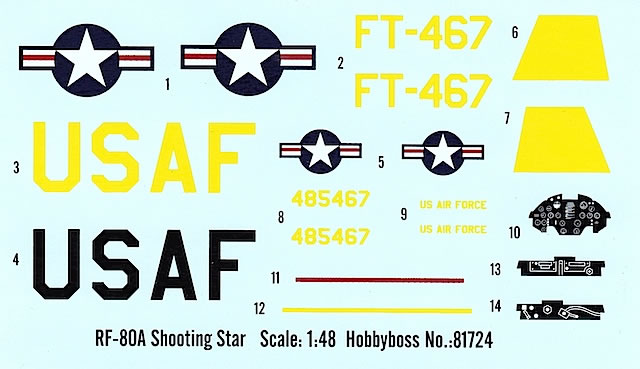|
RF-80A Shooting Star

HobbyBoss, 1/48 scale
S u m m a r y : |
Catalogue Number: |
HobbyBoss Kit No. 81724 – RF-80A Shooting Star |
Scale: |
1/48 |
Contents & Media: |
Approximately 91 grey plastic parts; 8 clear plastic parts; 1 decal sheet with markings for 1 aircraft; 1 small fret of photo-etched brass; 8 page A4 fold out black and white instruction sheet; 1 page A4 full colour painting and marking guide. |
Price: |
£17.99 plus postage available online from Creative Models Limited |
Review Type: |
First Look. |
Advantages: |
Interesting subject; plastic parts cleanly moulded with good surface detail on main airframe components and reasonable detail elsewhere; parts fit together well. |
Disadvantages: |
Dimensional errors of original P-80 kit carried across to this release; key RF-80 features missing or inaccurately represented; markings for only one aircraft. |
Conclusions: |
This kit is well moulded and should be easy to assemble. Unfortunately these positives are undermined by a range of accuracy issues that will result in the finished model being more of a caricature than accurate replica of an RF-80. |
Reviewed by Brad Fallen

HobbyBoss' 1/48 scale RF-80A Shooting Star is available online from Squadron.com
The Lockheed RF-80A was a dedicated photoreconnaissance variant of the P/F-80
Shooting Star. It first flew in May 1945 and entered production the following year. 152 RF-80As were built and along with a number of field-modified F-80s were key USAF reconnaissance assets during the Korean War; by the 1953 armistice the 67th Tactical Reconnaissance Group had flown most of its 60,000 missions on the type. This success notwithstanding, the RF-80’s inferiority to newer designs such as the MiG-15 saw it leave frontline service soon after the end of the war.
The P/F-80 and it derivatives have until recently been under-kitted in 1/48 scale. The 1970s Monogram P-80 kits make into beautiful models, but can be tricky to build. The Hobbycraft and particularly Testors T-33 kits are also showing their age.
HobbyBoss's announcement last year that it would be producing a 1/48 F-80 family was therefore welcomed. However this enthusiasm faded when it became clear the first kit released – a P-80A – had several accuracy issues including incorrectly shaped engine intakes and a fuselage that was too shallow for much of its length.
The engine intakes, particularly, detract from the appearance of the finished model but their location and complex shape make them difficult to correct. Other, lesser problems include HobbyBoss's provision of an ejection seat only (these were not fitted as standard until the P-80B series), and wheels with poorly defined hub detail.
HobbyBoss has now followed up with an RF-80A kit. To the best of my knowledge this is the first time we have seen an injection-moulded RF-80 in 1/48 scale, although resin conversions for the Monogram kit are available from Lone Star Models, C. and H. Aero Miniatures and Fox 3 Studios. The announcement of an injection-moulded replacement for these conversions would ordinarily be welcomed, but the problems with the HobbyBoss F-80A led to a subdued reception for the RF-80 boxing.
The 1/48 HobbyBoss RF-80A kit comes in a roughly A4 sized box that has reasonable artwork of the kit's single marking option (see below). Inside are five sprues of light g rey and one sprue of clear plastic parts. Moulding quality is up to HobbyBoss's usual high standard, with finely engraved panel lines and rivet detail on the main airframe components and fair detail elsewhere.
Fuselage breakdown is slightly non-conventional. Each half is moulded in two parts, split at the point where – on the real aircraft – the rear fuselage could be removed to facilitate engine servicing. This engineering has two purposes: helping modellers who want to display their model in a diorama setting (a reasonably complete J33 engine and trunking are provided), and making it easier for HobbyBoss to release different F-80 subtypes.
Dry fitting of the fuselage parts confirms they go together well, despite the way they have been engineered. The instructions recommend making up the front and rear fuselage sections as separate assemblies and then bringing them together, but I wouldn’t follow this advice unless you’re going to display your model with the engine on show. If you are finishing the model with the fuselage buttoned up I’d suggest building each fuselage half as a complete unit, which will eliminate the possibility of a step between the front and rear fuselage halves.
The wing is broken down more traditionally, with a full span lower wing and separate upper wing halves. Test fitting again reveals neat joins, including between the upper wing and fuselage, so assembly should be straightforward. Control surfaces are moulded in neutral positions apart from the flaps, which are separate parts and designed to be positioned dropped. You’ll need to remove some detail from inside the flaps if you want to install them retracted.
Three styles of wing tank are supplied, but only the standard tip tanks are required for the RF-80.
As mentioned in relation to the P-80 kit earlier in the review, all three wheels have soft hub detail and I would recommend aftermarket replacements from a manufacturer such as True Details.
The cockpit and nosewheel bay build up as a single unit that is trapped between the forward fuselage halves. Cockpit detail is good, but unfortunately HobbyBoss has used the parts included in its original P-80A release and made no attempt to replicate the features of an RF-80 cockpit. For example, a K-14 gunsight is provided for the top of the instrument panel, not the more appropriate camera control box.
Also potentially problematic is the seat, which represents an ejection seat as fitted to F-80Cs. My references are inconsistent regarding the type of seat installed in RF-80As. Some say ejection seats were fitted on the assembly line, while others (with which I am more inclined to agree) suggest these were not fitted until the aircraft were upgraded to F-80C standard later in their service lives. The seat itself is well detailed, being built up from eight plastic and six photo-etched parts.
All of these issues – cockpit, seat and wheels – are minor concerns that can be dealt with relatively easily, or ignored without seriously compromising the appearance of the finished model. There are, however, three major problems with the kit that will be difficult for modellers to correct, should they wish to do so.
The first two are the same issues that detracted from HobbyBoss’s original P-80A kit: poorly shaped engined intakes and a too-shallow fuselage. Some reviewers have suggested that HobbyBoss has made an effort to reshape the intakes between the P-80A and this release, but looking at photos of the relevant P-80 kit parts I don’t see much difference between the two. The RF-80 kit intakes are just wrong: next to photos of the real thing they are too shallow and too high, compared to the deep, almost pinched look of the original. The louvres just above and behind the intakes are also incorrectly positioned. The fuselage depth issue is harder to pick, but becomes noticeable when you look for it.

The third problem is unique to this kit, and relates to the RF-80’s photoreconnaissance equipment. Different RF-80 variants carried different numbers and types of cameras, but as explained by Larry Davis in “P/F-80 Shooting Star in Action” most factory-standard RF-80As were fitted with
a forward-aiming K-22 dicing camera (for close-up shots of individual targets) in the extreme forward end of the nose. In the mid-bay was K-17 left oblique, a K-17 vertical, and either a K-22 or K-17 right oblique camera. The aft bay had another pair of K-17 vertical cameras….
HobbyBoss has accurately captured the small port for the dicing camera at the front of the nose, and the nose profile itself is OK. However the camera port on the port side of the nose is poorly represented, with both the aperture and surrounding panel incorrectly shaped. Finally the camera windows underneath the nose are not depicted at all, with the surface of the parts between the nose gear bay and dicing camera aperture perfectly smooth. The windows can be scratch built, but their absence is a mystifying oversight by HobbyBoss.

These inaccuracies and omissions are frustrating, given the overall quality of the plastic parts. I encountered the same issues on a smaller scale when I reviewed HobbyBoss’s 1/48 Ta 152 C-11 earlier this year. With that kit HobbyBoss had modified its moulds to kit a different Ta 152 variant, but didn’t use the opportunity to correct some inaccurately shaped kit parts.
Marking Option
Most USAAF RF-80s were finished in overall natural metal and carried a variety of colourful unit markings, so HobbyBoss’s provision of markings for a single camouflaged machine is a little conservative. This aircraft is 485467/FT-467 of the 45th Tactical Reconnaissance Squadron, 67th TRG, based at Kimpo, Japan, 1952. FT-467 had Olive Drab upper surfaces and natural metal undersurfaces, with yellow codes and a yellow/red band on the rear fuselage. HobbyBoss suggests there should also be a broad yellow band on the vertical stabiliser, but reference photos of FT-467 show this band in the blue and white 'polka dots' of the 45th TRS. It may be that HobbyBoss has based its recommended markings on a scheme worn by FT-467 at a different time, but I haven't been able to find images to support this; if anyone has photos along these lines I'd be interested to see them.

The A4 painting and marking guide has full colour, four view drawings of FT-467 that clearly show camouflage demarcations and decal placement locations. Paint colours are called out in Mr Hobby, Vallejo, Model Master, Tamiya and Humbrol, which is comprehensive and welcome.
The small decal sheet has several problems, most noticeably US national markings that are out of register. I’d hesitate to use the yellow fin flash and fuselage band decals, which look slightly translucent, and while the instrument panel decal is reasonably convincing those for the cockpit side consoles are not.
HobbyBoss's 1/48 RF-80A kit is well moulded and should be reasonably straightforward to build.
However, the poorly shaped engine intakes result in a model that is more caricature than accurate replica, and will be beyond the ability of most modellers to correct. The misshapen or absent camera apertures will be easier to address, but are hard to explain given that that this is a dedicated RF-80 boxing.
The single marking choice is also disappointing, given the RF-80's importance to USAAF and United Nations operations in Korea.
Unfortunately, I cannot recommend this kit to anyone who wants an accurate 1/48 RF-80A out of the box.
Reference
Larry Davis, P/F-80 Shooting Star in Action (Squadron/Signal Publications,
2008).
Review Text and Images Copyright © 2014 by Brad Fallen
Page Created 6 October, 2014
Last updated
7 October, 2014
Back to HyperScale Main Page
Back to Reviews Page |
